Fatigue Analysis of a 40 ft LNG ISO Tank Container
Abstract
1. Introduction
2. Materials and Methods
2.1. Computational Domain and Materials
2.2. Computational Mesh
2.3. Boundary Conditions
3. Results
3.1. Maximum Principal Stress
3.2. Fatigue Analysis
4. Conclusions
Author Contributions
Funding
Institutional Review Board Statement
Informed Consent Statement
Data Availability Statement
Conflicts of Interest
Nomenclature
| Symbols and Abbreviations | Meaning |
| effective alternating equivalent stress amplitude | |
| fatigue strength reduction factor | |
| fatigue penalty factor | |
| component stress range | |
| the component stress range for different the fatigue penalty factor | |
| maximum allowable stress | |
| Poisson correction factor | |
| computed stress amplitude | |
| modulus elasticity of the material | |
| n | total number of the design cycles |
| N | the permissible number of cycles |
| the fatigue damage factor | |
| Y | stress factor used to compute X |
| X | exponent used to compute the permissible number of cycles |
| LNG | liquefied natural gas |
| ASME | American society of mechanical engineers |
| FDF | fatigue damage factor |
References
- Pham, V.C.; Choi, J.-H.; Rho, B.-S.; Kim, J.-S.; Park, K.; Park, S.-K.; Le, V.V.; Lee, W.-J. A numerical study on the combustion process and emission characteristics of a natural gas-diesel dual-fuel marine engine at full load. J. Energ. 2021, 14, 1342. [Google Scholar] [CrossRef]
- Boretti, A. Advances in diesel-LNG internal combustion engines. J. Appl. Sci. 2020, 10, 1296. [Google Scholar] [CrossRef]
- Cheenkachorn, K.; Poompipatpong, C.; Ho, C.G. Performance and emissions of a heavy-duty diesel engine fuelled with diesel and LNG (liquid natural gas). J. Energy 2013, 53, 52–57. [Google Scholar] [CrossRef]
- Ghadikolaei, M.A.; Cheung, C.S.; Yung, K.-F. Study of performance and emissions of marine engines fueled with liquefied natural gas (LNG). In Proceedings of the 7th PAAMES and AMEC2016, Hong Kong, China, 13–14 October 2016; Volume 13, p. 14. [Google Scholar]
- Li, J.; Wu, B.; Mao, G. Research on the performance and emission characteristics of the LNG-diesel marine engine. J. Nat. Gas Sci. Eng. 2015, 27, 945–954. [Google Scholar] [CrossRef]
- Lee, H.-J.; Yoo, S.-H.; Huh, S.-Y. Economic benefits of introducing LNG-fuelled ships for imported flour in South Korea. Transp. Res. Part D Transp. Environ. 2020, 78, 102220. [Google Scholar] [CrossRef]
- Fahy, M.; Tiernan, S. Finite element analysis of ISO tank containers. J. Mater. Process. Technol. 2001, 119, 293–298. [Google Scholar] [CrossRef]
- Fomin, O.; Vatulia, G.; Lovska, A. Dynamic load modelling for tank containers with the frame of circle pipes and structurally improved fittings. In Proceedings of the E3S Web of Conferences, Kenitra, Morocco, 25–27 December 2020; p. 07001. [Google Scholar]
- Lisowski, E.; Czyżycki, W. Transport and storage of LNG in container tanks. J. KONES 2011, 18, 193–201. [Google Scholar]
- Miana, M.; Del Hoyo, R.; Rodrigálvarez, V.; Valdés, J.R.; Llorens, R. Calculation models for prediction of Liquefied Natural Gas (LNG) ageing during ship transportation. J Appl. Energy 2010, 87, 1687–1700. [Google Scholar] [CrossRef]
- Muttaqie, T.; Sasmito, C.; Kadir, A. Structural Strength Assessment of 20-ft LNG ISO Tank: An Investigation of Finite Element Analysis and ASME Design Guidance. In IOP Conference Series: Earth and Environmental Science; IOP Publishing: Chiyoda, Tokyo, 2022; p. 012015. [Google Scholar]
- Tiernan, S.; Fahy, M. Dynamic FEA modelling of ISO tank containers. J. Mater. Process. Technol. 2002, 124, 126–132. [Google Scholar] [CrossRef]
- Wilson, J. An introduction to the marine transportation of bulk LNG and the design of LNG carriers. Cryogenics 1974, 14, 115–120. [Google Scholar] [CrossRef]
- Ganeshkumar, S.; Kumar, S.D.; Magarajan, U.; Rajkumar, S.; Arulmurugan, B.; Sharma, S.; Li, C.; Ilyas, R.; Badran, M.F. Investigation of tensile properties of different infill pattern structures of 3D-printed PLA polymers: Analysis and validation using finite element analysis in ANSYS. Materials 2022, 15, 5142. [Google Scholar] [CrossRef] [PubMed]
- Agrawal, A.P.; Ali, S.; Rathore, S. Finite element stress analysis for shape optimization of spur gear using ANSYS. Mater. Today Proc. 2022, 64, 1147–1152. [Google Scholar] [CrossRef]
- Wang, Z.; Qian, C. Strength analysis of LNG tank container for trains under inertial force. J. Physics Conf. Ser. 2020, 1549, 032107. [Google Scholar] [CrossRef]
- Cao, J.; Han, M.; Qi, J.Y. The Study on Medium Filling Scheme of LNG Tank Container Impact Testing Based on ANSYS. Adv. Mater. Res. 2014, 912–914, 869–872. [Google Scholar]
- Zhao, Y.; Li, H.-N.; Zhang, S.; Mercan, O.; Zhang, C. Seismic analysis of a large LNG tank considering different site conditions. J. Appl. Sci. 2020, 10, 8121. [Google Scholar] [CrossRef]
- Liguori, A.; Formato, A.; Pellegrino, A.; Villecco, F. Study of tank containers for foodstuffs. J. Mach. 2021, 9, 44. [Google Scholar] [CrossRef]
- Alshoaibi, A.M.; Fageehi, Y.A. Finite Element Simulation of a Crack Growth in the Presence of a Hole in the Vicinity of the Crack Trajectory. Materials 2022, 15, 363. [Google Scholar] [CrossRef] [PubMed]
- Boiler, A. Pressure Vessel Committee on Materials, 2017. In ASME Boiler and Pressure Vessel Code Section II, Materials, Part D Properties (Metric); Standard No. BPVC-IID-2017; American Society of Mechanical Engineers: New York, NY, USA, 2017. [Google Scholar]
- Lee, H.-H. Finite Element Simulations with ANSYS Workbench 18; SDC Publications: Mission, AR, USA, 2018. [Google Scholar]
- Alshoaibi, A.M.; Fageehi, Y.A. 3D modelling of fatigue crack growth and life predictions using ANSYS. Ain Shams Eng. J. 2022, 13, 101636. [Google Scholar] [CrossRef]
- ASME. Boiler, ASME Code, Pressure Vessel Section VIII; ASME: New York, NY, USA, 2007. [Google Scholar]
- ASME. Boiler, ASME Code, Pressure Vessel Rules for Construction of Pressure Vessels, Appendix Section Viii Division 1; ASME: New York, NY, USA, 2010; Volume 1. [Google Scholar]
- Zaretsky, E.V.A. Palmgren Revisited: A basis for bearing life prediction. In Proceedings of the STLE Annual Meeting, Kansas City, MO, USA, 18–22 May 1997. [Google Scholar]
- Langer, B. Design of pressure vessels for low-cycle fatigue. J. Basic Eng. 1962, 84, 389–399. [Google Scholar] [CrossRef]
- Miner, M.A. Cumulative damage in fatigue. J. Appl. Mech. 1945, 12, A159–A164. [Google Scholar] [CrossRef]
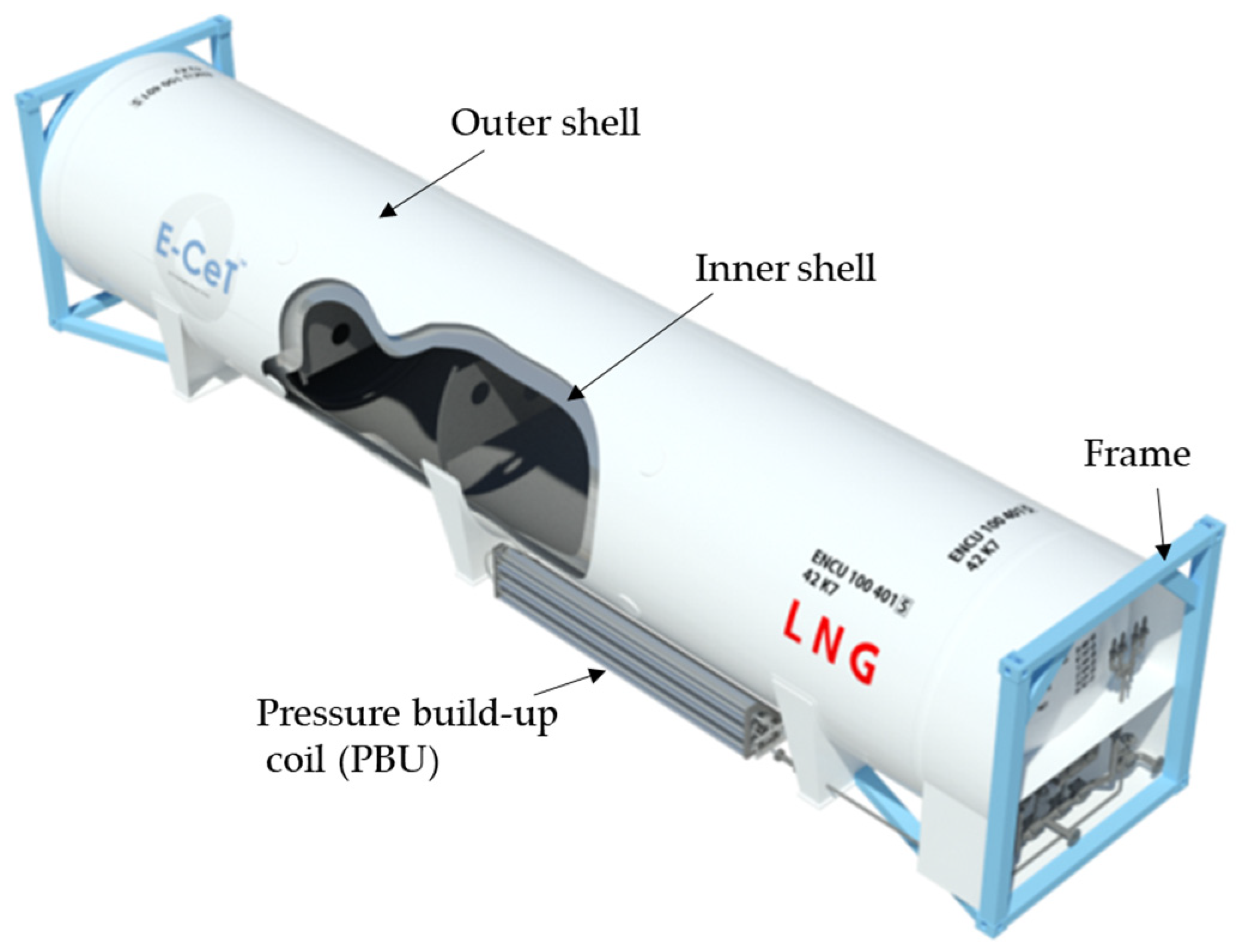
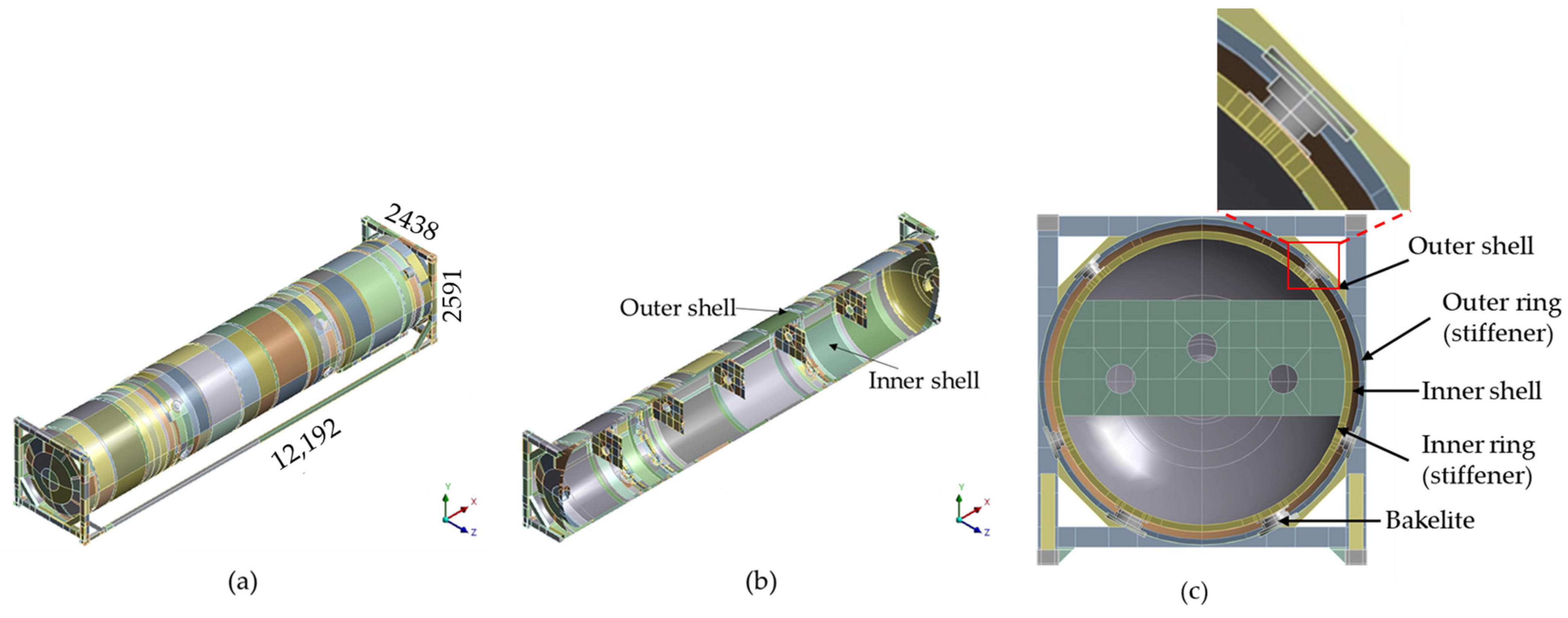
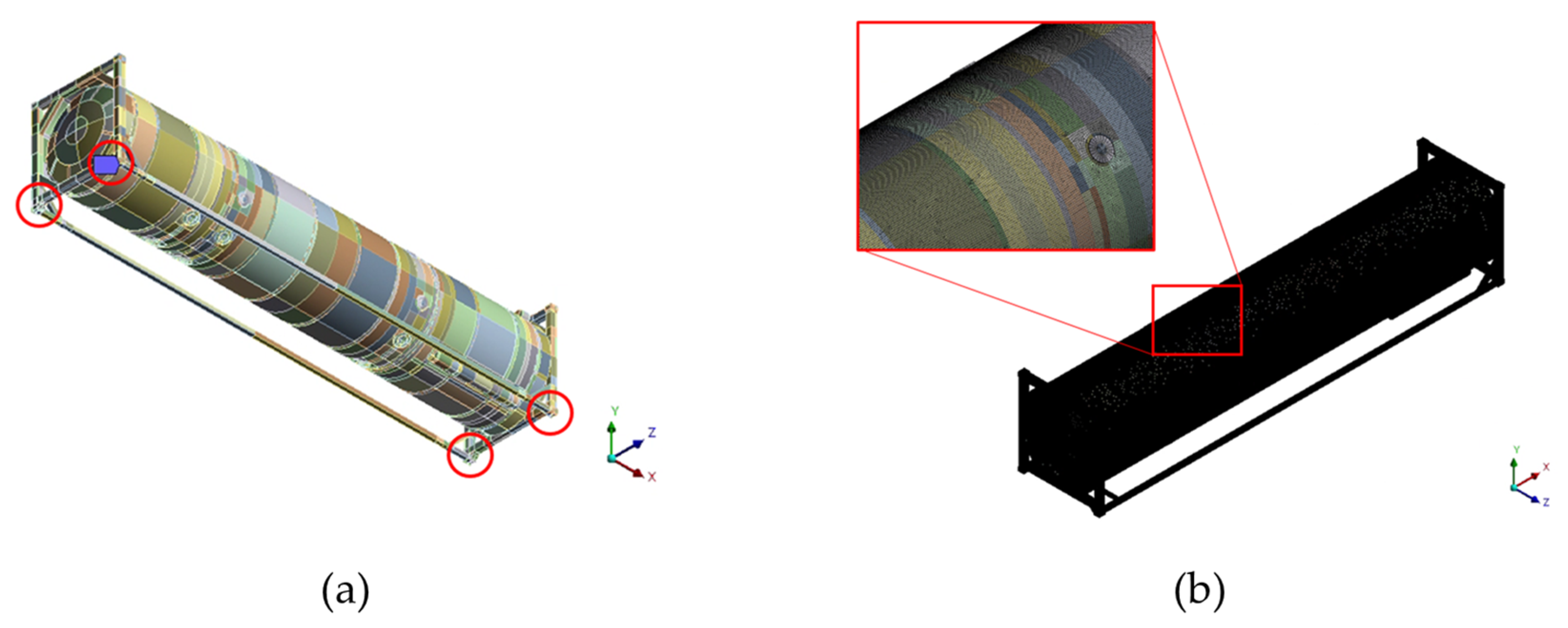



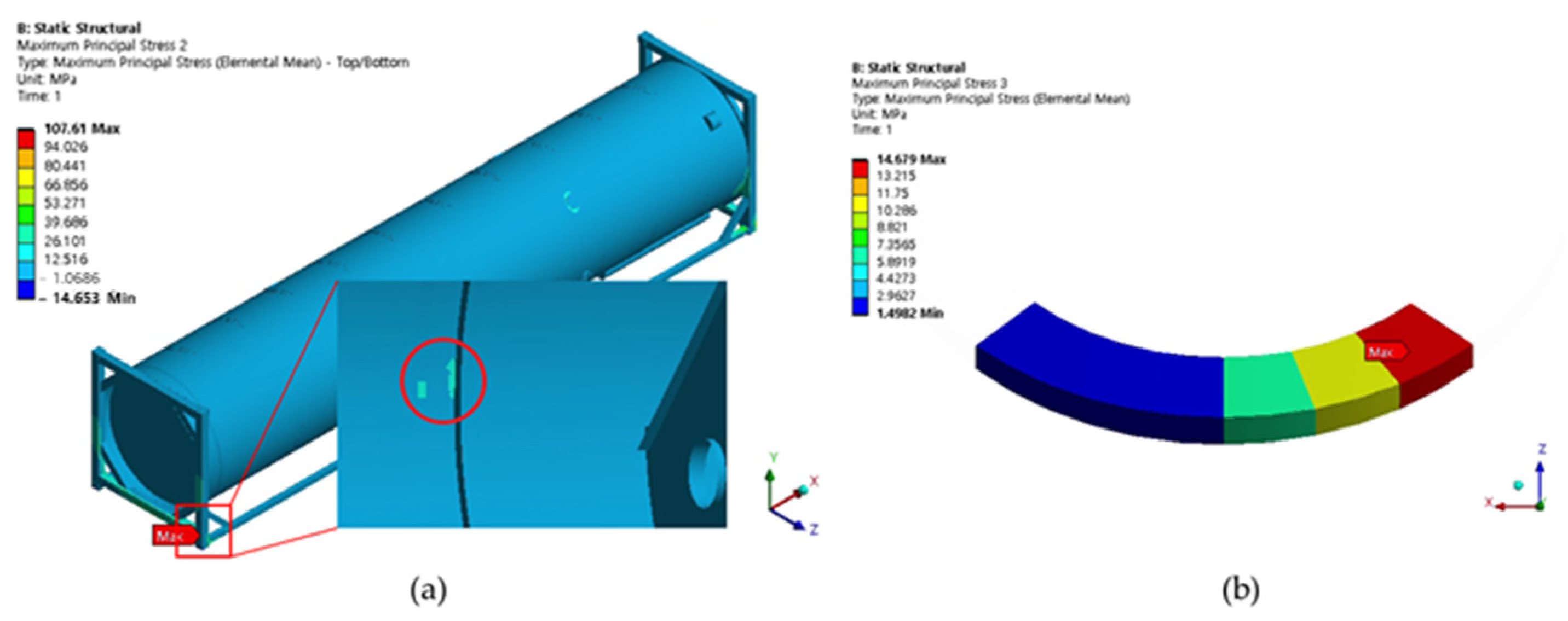
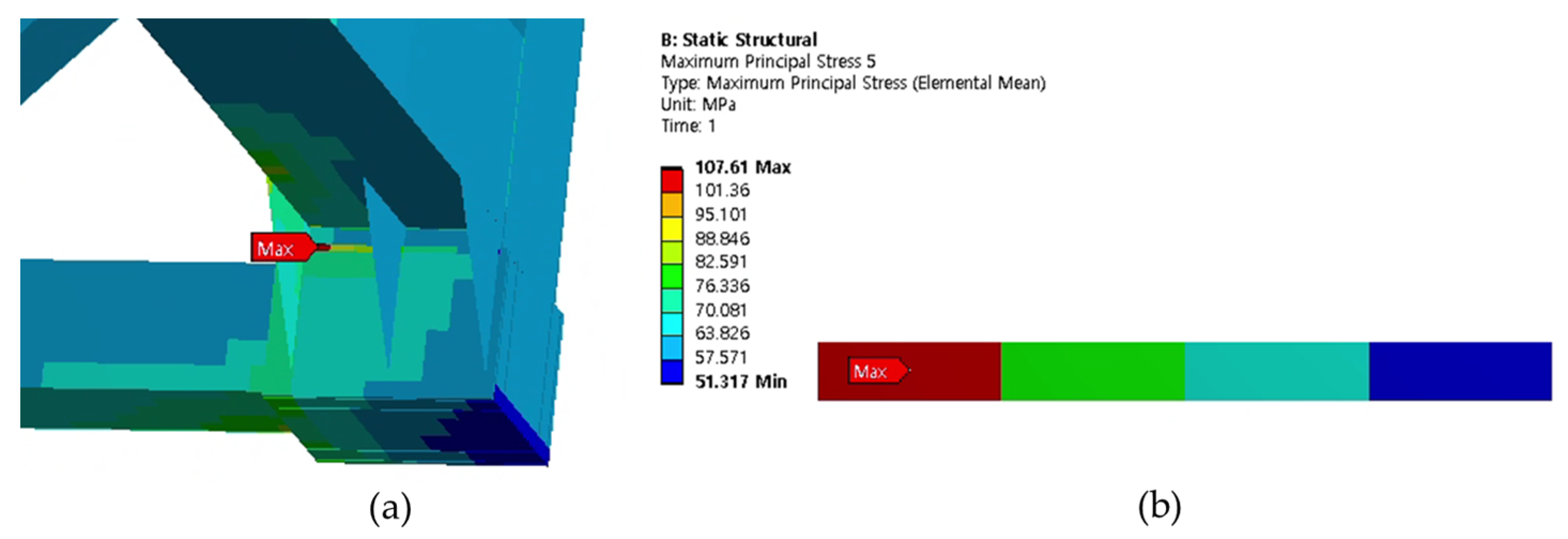
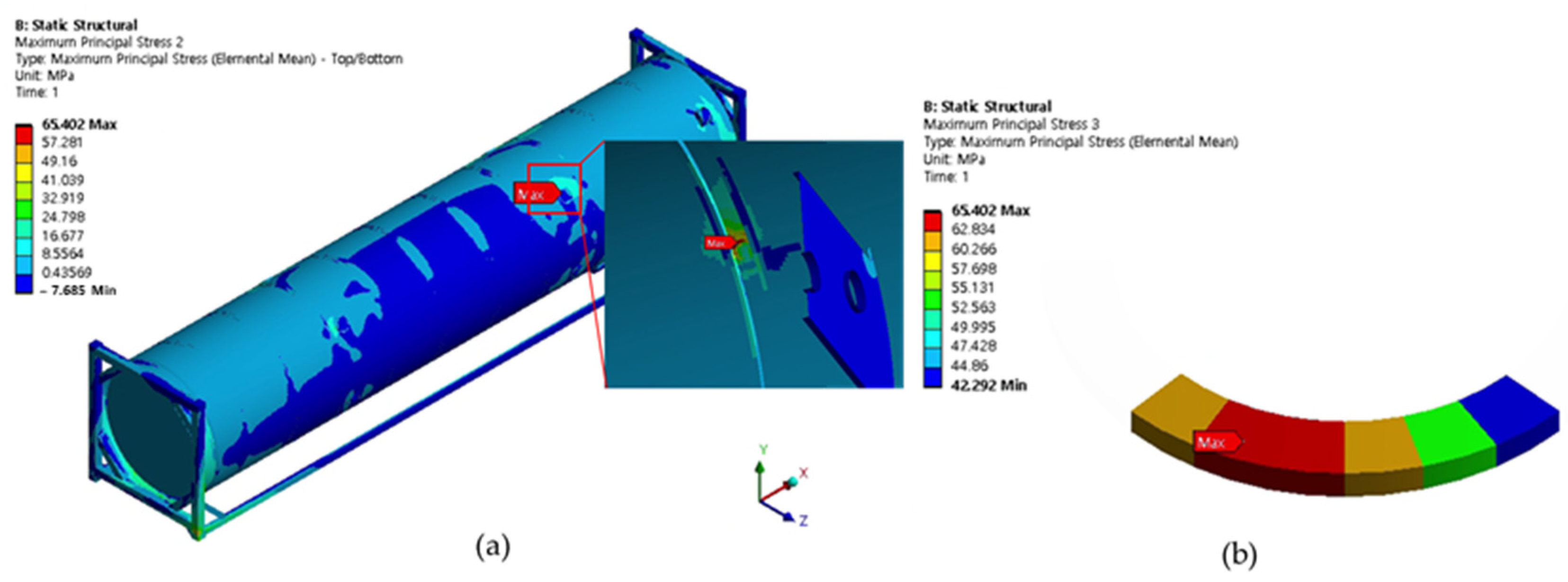
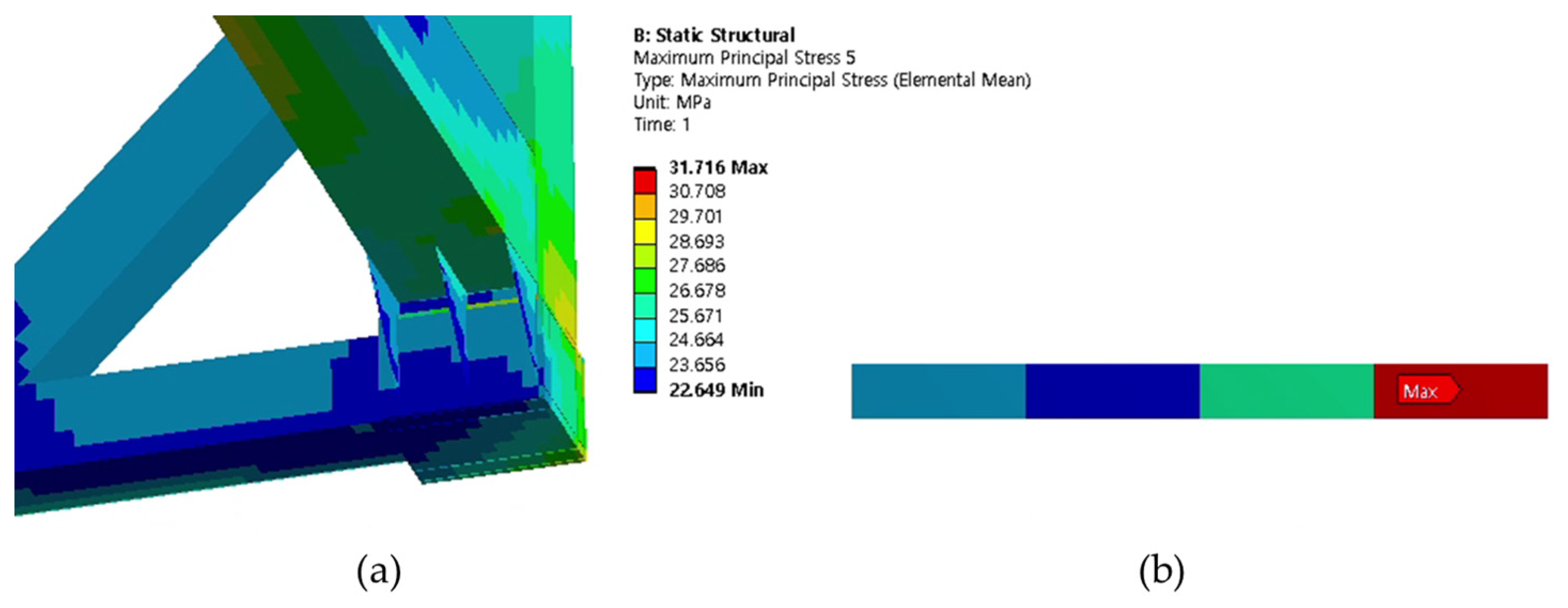

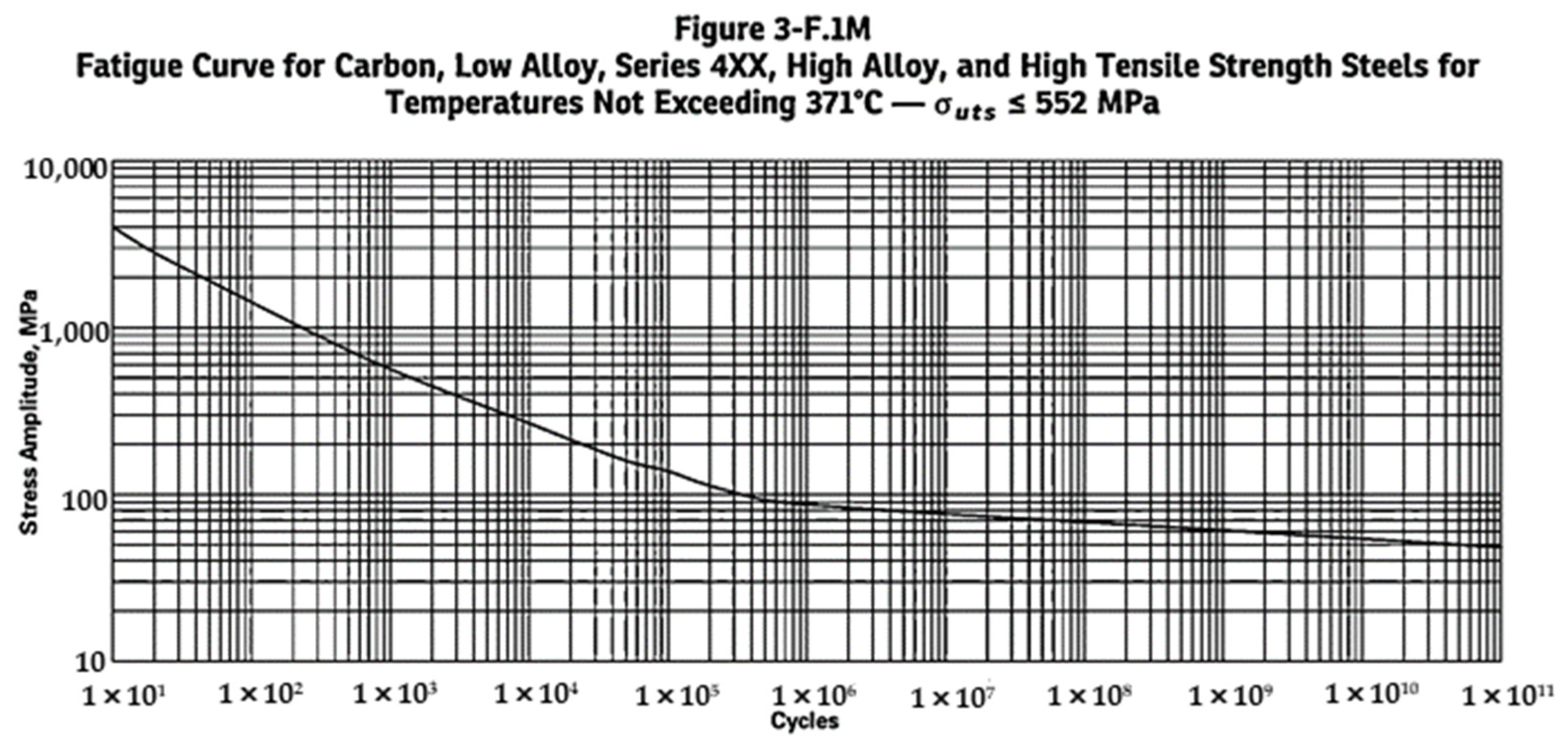
| Temperature (°C) | −196 | −138 | 10 | 50 |
| Thermal conductivity (W/mC) | 14.8 | 14.8 | 14.8 | 15.3 |
| Thermal expansion coefficient (1/K) | 15.3 | 15.3 | 15.3 | 15.6 |
| Young’s modulus (MPa) | 208,700 | 204,900 | 197,100 | 193,000 |
| Poisson’s ratio | 0.31 | 0.31 | 0.31 | 0.31 |
| Tensile strength (MPa) | 515 | 515 | 515 | 515 |
| Yield strength (MPa) | 138 | 138 | 138 | 138 |
| Density (kg/m3) | 8030 | 8030 | 8030 | 8030 |
| Temperature (°C) | −196 | −138 | 10 | 50 |
| Thermal conductivity (W/mC) | 60.4 | 60.4 | 60.4 | 59.8 |
| Thermal expansion coefficient (1/K) | 11.5 | 11.5 | 11.5 | 11.8 |
| Young’s modulus (MPa) | 215,800 | 212,700 | 204,500 | 200,700 |
| Poisson’s ratio | 0.3 | 0.3 | 0.3 | 0.3 |
| Tensile strength (MPa) | 400 | 400 | 400 | 400 |
| Yield strength (MPa) | 248 | 248 | 248 | 240.5 |
| Density (kg/m3) | 7750 | 7750 | 7750 | 7750 |
| Load Case | Maximum Principal Stress (MPa) | |
|---|---|---|
| Case 1 | Position 1 | 103.78 |
| Position 2 | 40.463 | |
| Case 2 | Position 1 | 14.679 |
| Position 2 | 107.61 | |
| Case 3 | Position 1 | 65.402 |
| Position 2 | 31.716 | |
| Case 4 | Position 1 | 123.2 |
| Parameter | Case 1 | Case 2 | Case 3 | Case 4 | |||
|---|---|---|---|---|---|---|---|
| Pos. 1 | Pos. 2 | Pos. 1 | Pos. 2 | Pos. 1 | Pos. 2 | Pos. 1 | |
| 1 | 1 | 1 | 1 | 1 | 1 | 1 | |
| 1.2 | 1.2 | 1.2 | 1.2 | 1.2 | 1.2 | 1.2 | |
| The component stress range [MPa] | 103.78 | 40.463 | 14.679 | 107.61 | 65.402 | 31.716 | 123.2 |
| [MPa] | 62.27 | 24.28 | 8.81 | 64.57 | 39.24 | 19.03 | 73.92 |
| [MPa] | 193,000 | 200,700 | 193,000 | 200,700 | 193,000 | 200,700 | 193,000 |
| Stress factor Y [MPa] | 0.960 | 0.534 | 0.111 | 0.959 | 0.760 | 0.429 | 1.035 |
| Exponent for permissible No. of cycles X | 8.719 | 19.398 | 36.604 | 8.744 | 12.845 | 23.523 | 7.184 |
| The permissible design cycles N | |||||||
| 0.191 | 0.000 | 0.000 | 0.181 | 0.000 | 0.000 | 0.000 | |
Disclaimer/Publisher’s Note: The statements, opinions and data contained in all publications are solely those of the individual author(s) and contributor(s) and not of MDPI and/or the editor(s). MDPI and/or the editor(s) disclaim responsibility for any injury to people or property resulting from any ideas, methods, instructions or products referred to in the content. |
© 2023 by the authors. Licensee MDPI, Basel, Switzerland. This article is an open access article distributed under the terms and conditions of the Creative Commons Attribution (CC BY) license (https://creativecommons.org/licenses/by/4.0/).
Share and Cite
Lee, D.-Y.; Jo, J.-S.; Nyongesa, A.J.; Lee, W.-J. Fatigue Analysis of a 40 ft LNG ISO Tank Container. Materials 2023, 16, 428. https://doi.org/10.3390/ma16010428
Lee D-Y, Jo J-S, Nyongesa AJ, Lee W-J. Fatigue Analysis of a 40 ft LNG ISO Tank Container. Materials. 2023; 16(1):428. https://doi.org/10.3390/ma16010428
Chicago/Turabian StyleLee, Du-Yong, Jae-Sang Jo, Antony John Nyongesa, and Won-Ju Lee. 2023. "Fatigue Analysis of a 40 ft LNG ISO Tank Container" Materials 16, no. 1: 428. https://doi.org/10.3390/ma16010428
APA StyleLee, D.-Y., Jo, J.-S., Nyongesa, A. J., & Lee, W.-J. (2023). Fatigue Analysis of a 40 ft LNG ISO Tank Container. Materials, 16(1), 428. https://doi.org/10.3390/ma16010428






